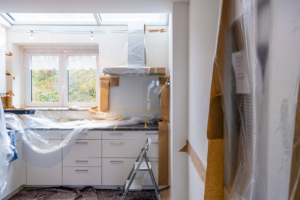Renovations are a part of homeownership. Anytime you live somewhere for an extended period of time, there are bound to be some projects you either want or need to take on. Whenever you do a construction project in your home, it could affect the air you breathe. Dirt, dust, and other particles filling the room are bound to interfere with the people in and around the area. Poor air quality can lead to mold and free-floating particles that can cause and exacerbate medical conditions like asthma and allergies. These indoor air pollutants can travel and cover surfaces throughout your home even if that doesn’t happen. From installations to expansions, here are five ways to prioritize air quality.
1. Close Your Vents
Your vent system is necessary to keep air circulating throughout your home. Without ventilation, dirty air can’t exit and clean air can’t enter the building. You also can’t have centralized heating or cooling without it. Closing the vents in the renovated rooms can help the rest of your home’s air stay clean. While your HVAC air filter will catch some of it, it might not get everything caused by an active work zone. Most vents have controls that let you manually open and close them as needed. Further, it’s a great way to help control differing temperatures throughout your home. You can even purchase special vent covers for significantly dusty situations.
2. Run Air Purifiers In Other Rooms

You can purchase air purifiers for different rooms throughout your home. They work to clean a set area, making it easy to know where the air is cleanest. You also need an air purifier that works for the space you’re working on. Check the square footage estimates to ensure adequate coverage. While you might not need a purifier in every room, keeping them running in the ones adjacent to your project can help keep your home’s air clean. Keep in mind that the wrong purifiers can use a lot of energy. Venta Air Purifiers, however, only use up to 33 watts at the highest speed.
3. Open Your Windows
Opening your windows is a simple solution to clean the air during small projects. The outside air will provide circulation to remove debris and allow the fresh air in. You should only use this method when the temperature is mild outside and there is a breeze, helping you to stay comfortable while maximizing the number of air pollutants exiting the home. Open windows create a cross breeze, helping the air flow more fluidly. You’ll want to keep the windows of the room you’re working on raised. If you are renovating an area where there are none, ensure you open the windows in adjacent rooms to help control the spread of particulate matter. If there is a chance large air pollutants will fly, consider only opening screened windows to prevent them from hitting passing people or animals.
4. Wear a Mask
When working on a project, moisture can get in the air and on surfaces. Without managing it, mold can grow on surfaces, travel through the air, and make household members sick. Mold can lead to several health conditions, such as skin rashes, lung irritability, watering eyes, post-nasal drip, and coughing. In rare cases, severe mold allergies can lead to serious side effects. You can avoid these conditions by filtering mold spores before they reach your lungs. Many home improvement stores and online vendors sell respirator masks that let you work safely in a potentially moldy environment. You can choose a reusable half-mask with replaceable filters or an N, R, or P-series mask. These projects are also great for using any N-95 masks from the COVID-19 pandemic. Avoiding mold spores preserves your and your family’s health throughout your renovation.
5. Avoid Renovation Zones

If you’re working in the renovation area, consider wearing an air filtration mask to stay healthy. Various respirators on the market filter particles out of the air before you breathe it in. It’s an instant process that doesn’t involve waiting for a purifier or breeze to clear the debris. When you can avoid being in the area, consider going to a different location during the working period. Waiting for the dust and debris to settle before entering your home can minimize the chance of breathing in harmful particles. Spending time outside also helps to avoid poor indoor air quality. Taking advantage of good weather to go on walks, play with the kids, or enjoy the sunshine is a great way to get some vitamin D and breathe the fresh air.
Prioritizing Air Quality During Renovation
Renovations can lead to particles that disrupt your home’s air quality. You can keep your household healthy by taking measures to keep breathing clean air.

